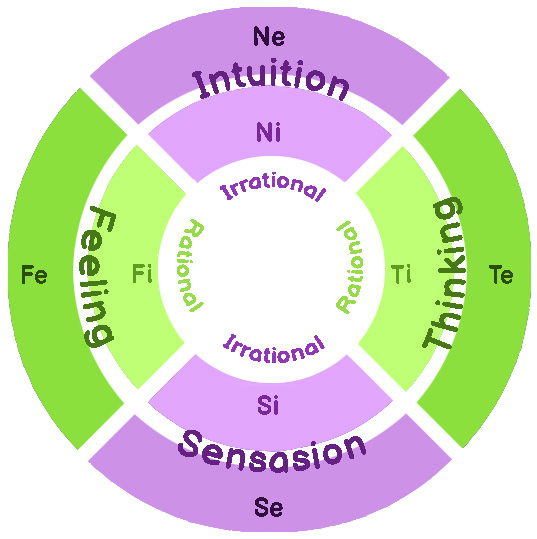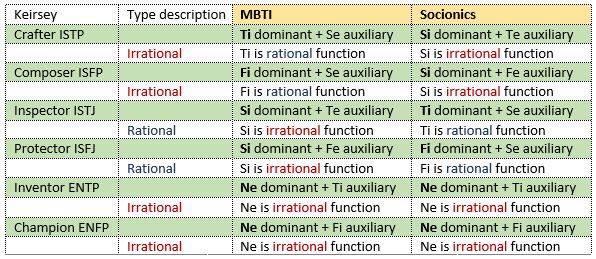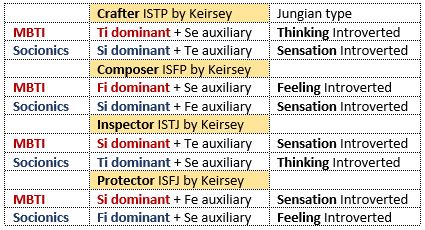Rationality/Irrationality in socionics and MBTI
 In his work "Psychological Types", Carl Jung divided all eight types into two groups: Rational and Irrational. According to Jung, a type is rational if its main (dominant) psychic function is rational, a type is irrational if its main psychic function is irrational. Jung considered Thinking and Feeling to be rational functions, and Sensation and Intuition to be irrational.
In his work "Psychological Types", Carl Jung divided all eight types into two groups: Rational and Irrational. According to Jung, a type is rational if its main (dominant) psychic function is rational, a type is irrational if its main psychic function is irrational. Jung considered Thinking and Feeling to be rational functions, and Sensation and Intuition to be irrational.
Socionics uses the same concept of rationality/irrationality as Carl Jung. The MBTI has the concept of Judging/Perceiving, which is considered to be the same as rationality/irrationality. Let's compare what is meant by the concept of Rationality/Irrationality in socionics and Judging/Perceiving in MBTI.
• Manifestations of Judging/Perceiving in MBTI (Isabel Myersʼ Clusters for MBTI Form G)
Judging – Perceiving
Spontaneity: Contrast between a scheduled and a spontaneous lifestyle.
Planning: Contrast between longer-term planning and going with the flow.
Organizing: Organizing the situation at hand, as opposed to long-term planning.
Application: Contrast between enjoying meeting the goal and finishing, versus enjoying something that catches interest; or between working for duty or pleasure.
Obligations: Contrast between being more serious or casual about meeting obligations.
Isabel Myersʼ Rules for MBTI Form G Clusters
|
Judging |
Perceiving |
|
|
Spontaneity |
Live comfortably with schedules, routines and systems |
Enjoy the variety of frequent changes; want time free and uncommitted |
|
Planning |
Enjoy arranging for activities ahead of time; like to have plans settled |
Prefer not to cross a bridge before reaching it |
|
Organizing |
Organise a job before starting it |
Start projects without feeling a need to organise beforehand |
|
Application |
Learn more by persistent effort than by exploring what engages curiosity. Real satisfaction out of finishing whatʼs started |
Learn more by exploring what engages curiosity than by persistent effort. Work best at jobs requiring a variety of activities or adaptability to handle changes, emergencies |
|
Obligations |
Orderly, systematic |
Casual, easy–going |
Source: CAPT Research Papers; some text has been adapted by Peter Geyer (1)
* * *
• Manifestations of Rationality/Irrationality in socionics.
|
Rationality |
Irrationality |
|
Acting according to plan (Acts) |
Acting spontaneously |
|
Prefers an orderly rhythm of life |
Prefers a flexible rhythm of life |
|
Tends to focus on one thing for a long time without distractions |
Inclined to direct perception, attention easily switches to new things |
|
Values order and reasonable restrictions, follows established laws and regulations |
Values the feeling of freedom, the opportunity to act spontaneously and creatively, freedom of choice |
|
Unplanned situations and surprises can cause stupor |
Feels overwhelmed by rules and restrictions |
|
Prefers definite wording and closure, has a clear position |
Avoids being categorical, likes when the choice remains open |
|
Plans purchases, controls expenses, tends to save |
Prone to spontaneous purchases, does not control expenses |
|
Can be perceived by others to be categorical and inflexible |
Can be perceived by others to be disorganized and inconsistent |
As we can see, the manifestations of Rationality/Irrationality in socionics are identical to the manifestations of Judgment/Perception in MBTI.
However, as we will see below, socionics and MBTI have opposite approaches to the definition of types associated with different applications of Rationality/Irrationality.
Let's take as an example the description of the type Crafter (ISTP) by David Keirsey (2)
The Crafter (ISTP). Excerpt from the description:
“The Crafter's tool artisanship is masterful, but it is also born of impulse rather than of deliberate purpose. For these Artisans, action is more enjoyable-and more effective-if it is unplanned, serving no purpose other than the doing. ISTPs prefer their actions to be spontaneous and unfettered; they want to follow their own lead, and to have their own impulses not subject to rules, regulations, or laws. Indeed, Crafters can be fiercely insubordinate, seeing hierarchy and authority as unnecessary and even irksome. It is not so much a matter of going against regulations as it is simply ignoring them, and not allowing them to influence execution. ISTPs must be free to do their thing, varying each next move as the urge strikes them, and they are proud of their ability to make the next move skillfully. In a sense, Crafters do not work with their tools, but play with them on impulse and not on schedule. If an externally imposed schedule coincides with their impulse, fine; if not, so much the worse for the schedule.”
From this description, it is clear that the Crafter (ISTP) belongs to the Irrational type. According to Jung, a type is irrational if its main (dominant) psychic function is irrational. The irrational functions are Sensation and Intuition. Therefore, the main psychic function of the type Crafter (ISTP) should be Sensasion or Intuition. Socionics classifies the type Crafter as a type with the main function introverted Sensasion. This is fully consistent with Jung's concept of rationality/irrationality.
However, MBTI classifies the type Crafter (ISTP) as a type with the main function - introverted Thinking, which very surprises socionists. After all, according to Jung's typology, Thinking is a rational function. It is not clear how a rational function can be the dominant function of an irrational type.
In the MBTI, the parameter rationality/irrationality of the type coincides with the rationality/irrationality of the dominant psychic function only for extraverted types.
Due to the different use of the parameter rationality/irrationality, the Crafter ISTP type, socionics refers to Jungian Sensing Introverted, and MBTI refers Crafter to Jungian Thinking Introverted.
This basic misunderstanding with the rationality/irrationality parameter leads to the fact that in MBTI the study of intertype relationships comes to a dead end, while in socionics the study of intertype relationships is well developed.
Upon closer acquaintance with the MBTI, you can see that in MBTI separate functions are not distinguished, each of the 16 types is described as a whole, without division into functions. In the MBTI type descriptions, it is not clear which function is described: dominant, auxiliary, or another. In contrast to MBTI, socionics, in addition to the general description of the type, also indicates the role of each of the 8 functions in the manifestation of this type. For example, for the type Crafter, each of the 8 functions is described separately and explained how exactly it manifests itself in the behavior of the type Crafter. Moreover, socionics describes what relationships the type Crafter can have with each of the 16 types, and explains how each of the 8 functions of the type Crafter interacts with each of the 8 functions of the other type.
* * *
1 - CAPT - Center for Applications of Psychological Type www.capt.org Peter Geyer C.G.Jung's psychological types, the MBTI, and ideas of social adjustment. March 2014 >>>
2 - David Keirsey «Please Understand Me»
Last undating 23.11.2023.


